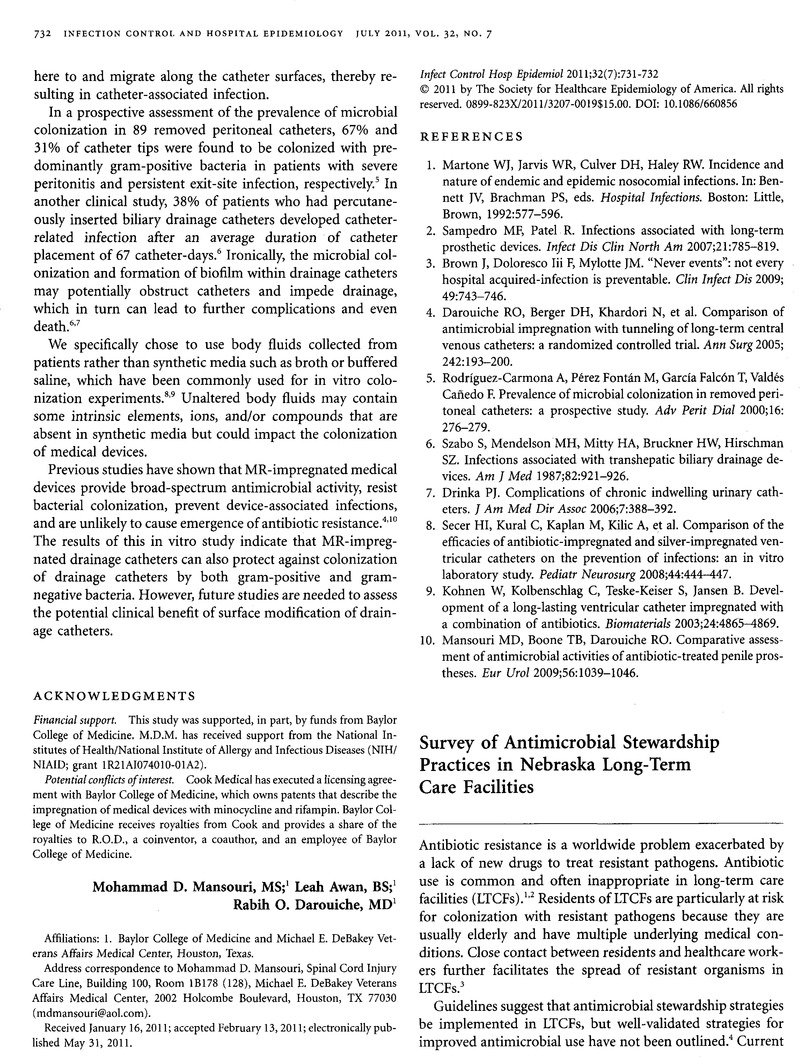Crossref Citations
This article has been cited by the following publications. This list is generated based on data provided by Crossref.
McGowan, John E.
2012.
Antimicrobial Stewardship—the State of the Art in 2011 Focus on Outcome and Methods.
Infection Control & Hospital Epidemiology,
Vol. 33,
Issue. 4,
p.
331.
Jump, Robin L. P.
Olds, Danielle M.
Seifi, Nasim
Kypriotakis, Georgios
Jury, Lucy A.
Peron, Emily P.
Hirsch, Amy A.
Drawz, Paul E.
Watts, Brook
Bonomo, Robert A.
and
Donskey, Curtis J.
2012.
Effective Antimicrobial Stewardship in a Long-Term Care Facility through an Infectious Disease Consultation Service: Keeping a LID on Antibiotic Use.
Infection Control & Hospital Epidemiology,
Vol. 33,
Issue. 12,
p.
1185.
Nicolle, Lindsay E
2012.
Antimicrobial Resistance in Long-Term Care Facilities.
Future Microbiology,
Vol. 7,
Issue. 2,
p.
171.
Jump, Robin L. P.
Olds, Danielle M.
Jury, Lucy A.
Sitzlar, Brett
Saade, Elie
Watts, Brook
Bonomo, Robert A.
and
Donskey, Curtis J.
2013.
Specialty Care Delivery: Bringing Infectious Disease Expertise to the Residents of a Veterans Affairs Long‐Term Care Facility.
Journal of the American Geriatrics Society,
Vol. 61,
Issue. 5,
p.
782.
Moro, Maria Luisa
and
Gagliotti, Carlo
2013.
Antimicrobial Resistance and Stewardship in Long-Term Care Settings.
Future Microbiology,
Vol. 8,
Issue. 8,
p.
1011.
Lim, Ching Jou
Kwong, Megan
Stuart, Rhonda L
Buising, Kirsty L
Friedman, N Deborah
Bennett, Noleen
Cheng, Allen C
Peleg, Anton Y
Marshall, Caroline
and
Kong, David CM
2014.
Antimicrobial stewardship in residential aged care facilities: need and readiness assessment.
BMC Infectious Diseases,
Vol. 14,
Issue. 1,
Howard, P.
Pulcini, C.
Levy Hara, G.
West, R. M.
Gould, I. M.
Harbarth, S.
and
Nathwani, D.
2015.
An international cross-sectional survey of antimicrobial stewardship programmes in hospitals.
Journal of Antimicrobial Chemotherapy,
Vol. 70,
Issue. 4,
p.
1245.
Dyar, O.J.
Pagani, L.
and
Pulcini, C.
2015.
Strategies and challenges of antimicrobial stewardship in long-term care facilities.
Clinical Microbiology and Infection,
Vol. 21,
Issue. 1,
p.
10.
Jump, Robin L.P.
Heath, Barbara
Crnich, Christopher J.
Moehring, Rebekah
Schmader, Kenneth E.
Olds, Danielle
and
Higgins, Patricia A.
2015.
Knowledge, beliefs, and confidence regarding infections and antimicrobial stewardship: A survey of Veterans Affairs providers who care for older adults.
American Journal of Infection Control,
Vol. 43,
Issue. 3,
p.
298.
Morrill, Haley J.
Mermel, Leonard A.
Baier, Rosa R.
Alexander-Scott, Nicole
Dosa, David
Kavoosifar, Sara
Reece, Rebecca
and
LaPlante, Kerry L.
2016.
Antimicrobial Stewardship in Rhode Island Long-Term Care Facilities: Current Standings and Future Opportunities.
Infection Control & Hospital Epidemiology,
Vol. 37,
Issue. 8,
p.
979.
Bradley, Suzanne F.
2016.
Antimicrobial Stewardship and Infection Prevention in Long-Term Care Settings: New Strategies to Prevent Resistant Organisms.
Current Geriatrics Reports,
Vol. 5,
Issue. 1,
p.
16.
Morrill, Haley J.
Caffrey, Aisling R.
Jump, Robin L.P.
Dosa, David
and
LaPlante, Kerry L.
2016.
Antimicrobial Stewardship in Long-Term Care Facilities: A Call to Action.
Journal of the American Medical Directors Association,
Vol. 17,
Issue. 2,
p.
183.e1.
Malani, Anurag N.
Brennan, Brenda M.
Collins, Curtis D.
Finks, Jennie
Pogue, Jason M.
and
Kaye, Keith S.
2016.
Antimicrobial Stewardship Practices in Michigan Long-Term Care Facilities.
Infection Control & Hospital Epidemiology,
Vol. 37,
Issue. 2,
p.
236.
McElligott, Miranda
Welham, Grace
Pop-Vicas, Aurora
Taylor, Lyndsay
and
Crnich, Christopher J.
2017.
Antibiotic Stewardship in Nursing Facilities.
Infectious Disease Clinics of North America,
Vol. 31,
Issue. 4,
p.
619.
MORIOKA, Shinichiro
KUWAE, Fumiko
and
OHMAGARI, Norio
2017.
Epidemiology on Multidrug-resistant Organisms and Effective Antimicrobial Stewardship through a Multifaceted Educational Intervention in a Japanese Long-term-care Hospital.
Japanese Journal of Infection Prevention and Control,
Vol. 32,
Issue. 4,
p.
201.
Kullar, Ravina
Yang, Haoshu
Grein, Jonathan
and
Murthy, Rekha
2018.
A Roadmap to Implementing Antimicrobial Stewardship Principles in Long-term Care Facilities (LTCFs): Collaboration Between an Acute-Care Hospital and LTCFs.
Clinical Infectious Diseases,
Vol. 66,
Issue. 8,
p.
1304.
Tandan, M
Burns, K
Murphy, H
Hennessy, S
Cormican, M
and
Vellinga, A
2018.
Antimicrobial prescribing and infections in long-term care facilities (LTCF): a multilevel analysis of the HALT 2016 study, Ireland, 2017.
Eurosurveillance,
Vol. 23,
Issue. 46,
Johnson, Candace L.
Jain, Meaghan
Saiman, Lisa
and
Neu, Natalie
2018.
Antimicrobial stewardship in pediatric post-acute care facilities.
American Journal of Infection Control,
Vol. 46,
Issue. 4,
p.
468.
Palms, Danielle L
Kabbani, Sarah
Bell, Jeneita M
Anttila, Angela
Hicks, Lauri A
and
Stone, Nimalie D
2019.
Implementation of the Core Elements of Antibiotic Stewardship in Nursing Homes Enrolled in the National Healthcare Safety Network.
Clinical Infectious Diseases,
Vol. 69,
Issue. 7,
p.
1235.
Hussain, Syed Wasif
and
Ashraf, Muhammad Salman
2020.
Clostridium Difficile Infection in Long-Term Care Facilities.
p.
7.



